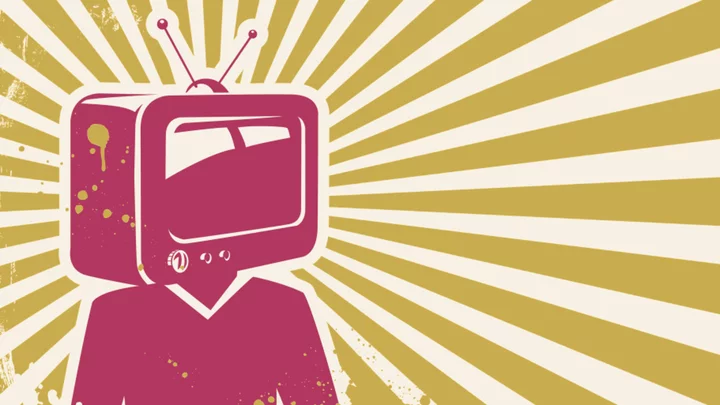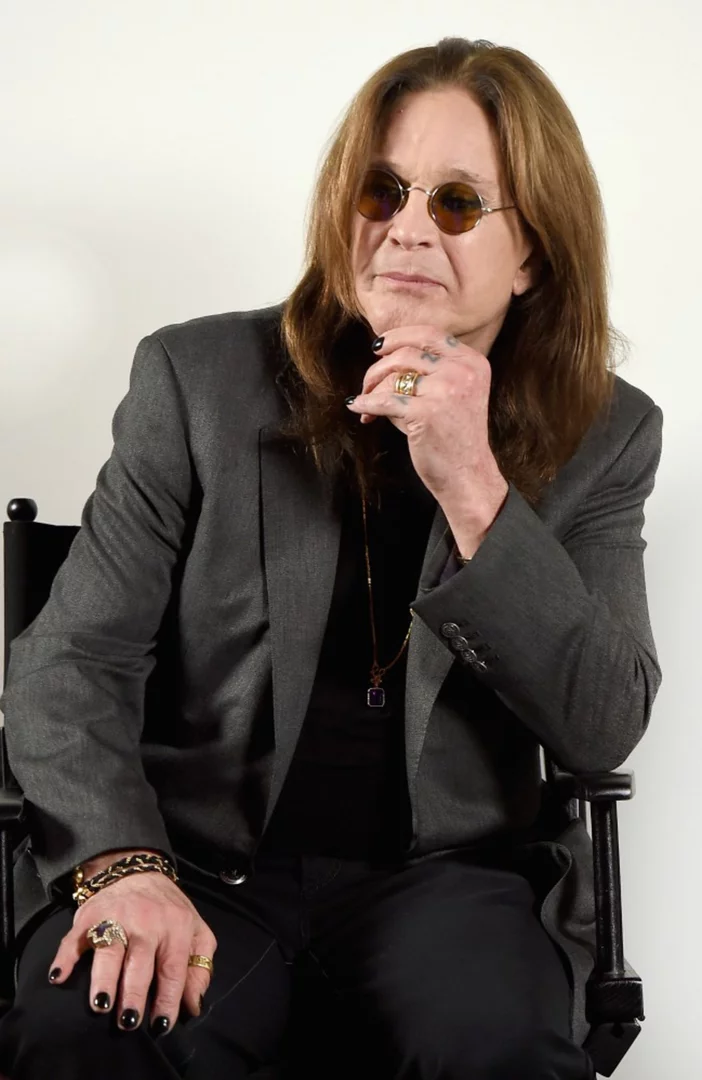Most of the basic English names for colors—like red, yellow, and green—are among the oldest recorded words in our language and can be traced right back to the Old English period. One exception to that rule is the color orange, which didn’t begin to appear in the language until after oranges (the fruit) were imported into Britain from Europe in the Middle Ages. Before then, what we would describe as orange today had just to be called either red or yellow (or, if you wanted to be really specific, red-yellow).
But the English language being as enormous as it is, a predictably vast vocabulary of words have been invented, borrowed, and accumulated over the centuries to describe almost every color and shade imaginable—from the precise color of a bear’s ears to the murky green of goose droppings. Here are some brilliantly-named examples of colors you’ve probably never heard of.
1. Australien
The 1897 guide House Decoration includes, in a chapter dedicated to mixing oil paints, “a list of new colors for ladies’ dresses,” among which is australien. Inspired by the rusty color of the rocks and deserts of the Australian outback, the name australien was used by dressmakers and fashion houses in late Victorian England for a deep orange color.
2. Banan
The color of a ripe banana? That’s banan.
3. Bastard-Amber
Bastard-amber is the name of an amber-colored spotlight used in theaters to produce a warm peach or pink glow on stage. It’s often used to recreate sunlight, or to give the illusion of dawn or dusk.
4. Drake’s-Neck
The drake in question here is the male mallard, a species of duck found across North America, Europe, and Asia. The males have an iridescent bottle-green head and neck, which gave its name to a rich green-colored dye called drake’s-neck in the early 18th century.
5. Drunk-Tank Pink
Drunk-tank is the name of a bright shade of pink that has been the subject of a number of studies on the effects of colors on human temperament. This particular color—also known as Baker-Miller pink, after the two U.S. Navy officers who invented it—has been demonstrated in numerous experiments to have a calming influence, and so is often used in prisons and police holding cells to help keep the people inside relaxed and to discourage unruly behavior.
6. Flame-of-Burnt-Brandy
As the dyeing industry developed in the 19th century and was able to produce more and more colors, dressmakers and designers were left to concoct a whole range of weird and wonderful names for the new hues at their disposal. Flame-of-burnt-brandy was just one of them, described in 1821 by one ladies’ magazine as a mixture of “lavender grey, pale yellow, and dark lilac.” Other equally evocative names dating from the same period include dragon’s blood (a deep purplish-red), d’oreille d’ours (a rich brown, literally “bear’s ears”), elephant’s breath (steel gray), and flamme de Vesuve ("the flame of Vesuvius," or the color of lava).
7. Gingerline
Not just another word for anything ginger-colored, gingerline is often said to be a reddish-violet or reddish-brown color. However, by other accounts it describes a rich orange-yellow. According to one description, it refers very precisely to the color of ripe kumquats.
8. Lusty Gallant
Lusty gallant was originally the name of a dance popular in Tudor England, but somehow, in the late 1500s, its name became attached to a pale shade of red, similar to coral pink. Quite how or why this happened is unclear, but according to the Elizabethan writer William Harrison, dressmakers at the time had a habit of giving increasingly bizarre names to the colors of their clothes in the hope of making them more appealing to buyers. In his Description of England, written in 1577, Harrison lists the names of several “hues devised to please fantastical heads,” including “gooseturd green, pease-porridge tawny, popinjay blue, lusty-gallant, [and] the-devil-in-the-head.”
9. Nattier
Jean-Marc Nattier (1685-1766) was a French Rococo artist known for a series of portraits of women from the court of Louis XV of France depicted as characters from Greek mythology. Despite achieving enormous popularity during his lifetime—his contemporaries thought his work so exquisite that they even accused him of painting with makeup rather than paint—Nattier is relatively little-known today, but he lives on in the name of a deep shade of slate-blue that he used in a number of his paintings, most notably a portrait of The Comtesse de Tillières (1750), nicknamed “The Lady in Blue.”
10. Pervenche
Pervenche is the French word for periwinkle, which came to be used in English in the 19th century as another name for the rich color of periwinkle flowers.
11. Sang-de-Boeuf
Unsurprisingly, sang-de-boeuf, or “oxblood,” is the name of a rich shade of red that was originally a blood-colored pottery glaze made with copper. Although the name sang-de-boeuf dates back no further than the late 19th century, the technique used to manufacture oxblood glazes was first developed possibly as far back as the 1200s in China.
12. Sinoper
Popular among Renaissance artists, sinoper or sinople was an artist’s pigment containing particles of hematite, an iron-rich mineral that gave it a rich rust-red color. Its name comes from the town of Sinop on the Black Sea coast of Turkey, from where it was first imported into Europe in the late Middle Ages.
13. Verditer
Verditer is both an old fashioned name for verdigris, the green rust-like discoloration of copper and brass, and the name of a blue-green pigment dating from the 1500s. Its name, which is derived from the French verte-de-terre, or “green of the earth,” is today used in the name of a bright turquoise songbird, the verditer flycatcher, which is native to the Himalayas.
14. Watchet
Watchet is a very pale blue color. According to folk etymology, the color takes its name from the town of Watchet on the coast of Somerset in southwest England, the cliffs around which appear pale blue because they are rich in alabaster. But as neat a story as this is, it’s much more likely that watchet is really derived from waiss, an old Belgian-French word for royal blue.
15. Zaffre
Zaffre is the name of an ancient blue pigment originally produced by burning ores of cobalt in a furnace. Its name was borrowed into English from the Italian zaffera in the 17th century, and is ultimately descended from the Latin word for “sapphire.”
16. Puke
Not even goose-turd green can rival the ick-factor of a color called “puke.” Thankfully, this one is unrelated to vomit. Back in the 1500s, puke was a high-end wool cloth often used to make gowns and stockings. The word came to describe the color those items were dyed, though there wasn’t one universal understanding of what that color actually was.
In the 1530s, scholar Thomas Elyot pegged it as “betwene russet & black.” Several decades later, linguist John Florio mentioned “a deepe darke purple or puke colour”—so it was definitely pretty dark. You can probably chalk up the inconsistency to a lack of quality control in the 16th-century dye-making industry. Whatever shade Shakespeare was picturing when he mentioned a “puke stocking” in Henry IV Part 1 is lost to history.
17. Incarnadine
Shakespeare’s use of the word incarnadine in Macbeth is much more clearly defined. In Act 2, Scene 2, Macbeth says this [PDF]:
“Will all great Neptune’s ocean wash this blood
Clean from my hand? No, this my hand will rather
The multitudinous seas incarnadine,
Making the green one red.”
In other words, there’s so much blood on his hands that it could turn the ocean red. But there’s one tiny problem with the verb incarnadine here: At the time, it didn’t mean to turn something blood-red. It referred to dyeing something flesh-colored, specifically the pale pink of white people’s skin. Think carnations.
The Bard tweaked the meaning to better suit his story, or maybe just to fit the constraints of iambic pentameter. Who knows? But such was his influence that ever since Macbeth, the term incarnadine has been associated with blood-red.
18. Filemot
The dull brown or yellowish brown of a dead leaf is called “filemot,” from the French term feuille morte. It just means “dead leaf.”
19. Coquelicot
Other color names have been borrowed from French sans updates. Coquelicot, meaning “poppy,” describes the vibrant orange-red of a poppy flower.
20. Eau-de-Nil
One hue that had a particular hold over Western fashion and decor in the early to mid-20th century was eau-de-Nil, French for “water of the Nile.” As Katy Kelleher wrote for The Paris Review, it’s “a tricky color to pin down precisely. It is a light-greenish hue, more saturated than celadon, less gray than sage. It has tan undertones and a cool bluish cast.”
You can find a couple notable examples in the films of Alfred Hitchcock. Costume designer Edith Head dressed Grace Kelly in an eau-de-Nil suit in Rear Window, and she reused the color for Tippi Hedren in The Birds.
21. Rufous
Speaking of birds, in the 1780s, naturalist John Latham described various species as “rufous,” meaning brownish-red or rust-colored. The term comes from rufus, a Latin word for red, often something more like red-haired.
Latham was the first person documented in the Oxford English Dictionary to use the Anglicized version, but the trend of describing wildlife as “rufous” didn’t stop with him. Today, we have the rufous hummingbird, the rufous rat kangaroo, and more rufous-colored critters.
22. Glaucous
Popping an o into the Latin word for a color to form a new-ish English adjective was popular among early naturalists. Glaucus became glaucous, typically describing a pale, grayish blue or green—like the frosted or powdery coating that forms on grapes and other fruit.
23. Fulvous
Fulvus became fulvous, a “dull brownish yellow,” per Merriam-Webster. Think tawny like a lion’s mane.
24. Wenge
Wenge describes a much darker brown—specifically that of the Millettia laurentii, a legume tree native to Central Africa. Wenge wood is known for its durability and resistance to termites.
25. Melichrous
Why call a honey-colored substance “honey-colored” when you could call it “melichrous”? In Greek, meli means “honey.”
26. Xanadu
You probably know Xanadu as the title track of a trippy 1980 movie musical starring Olivia Newton-John. Or as the alternate name of the Mongol city of Shangdu dreamed up by Samuel Taylor Coleridge in his poem “Kubla Khan.” Xanadu is also a dull grayish-green—maybe not what you’d picture in a “stately pleasure-dome.”
27. Feldgrau
But grayish-green is pretty ideal for military uniforms. Feldgrau, German for “field gray,” describes the shade worn by 20th-century German soldiers.
28. Phlox
To botanists, phlox is a genus of more than five dozen plant species, some of which bloom in bright pinks and purples. To artists, phlox is an especially fluorescent hue also known as “psychedelic purple.” A must-have on any tie-dyed T-shirt. You can watch a totally silent 12-hour YouTube video of a blank screen of the color phlox above.
29. Vinaceous
Vinaceous is a descriptor that leaves a little room for interpretation. It just means “the color of red wine.” Somewhere, a sommelier is rolling their eyes at such a sinful lack of specificity.
30. Solferino
Other colors owe their monikers to places on the map. Solferino in Lombardy, Italy, is the namesake of a purple-red dye discovered not long after the Battle of Solferino—a decisive event in the second war for Italian independence. Magenta, by the way, was named after the Battle of Magenta from the same conflict.
31. Falu Red
If you’re driving around Sweden and see a red barn, that color is commonly known as falu. It gets its name from Falun, a Swedish city once famous for its copper mines. The byproducts of all that mining didn’t go to waste: Locals combined them with linseed oil to make a rusty-red paint that’s still the gold standard for farm charm today.
32. Labrador Blue
Labrador, Canada, didn’t just lend its name to a beloved dog breed. Labrador blue is the muted grayish-blue associated with labradorite—a sometimes iridescent feldspar mineral first found in the region.
33. Isabella
Isabella or isabelline describes a yellowish brown, grayish yellow, or some other faded neutral hue. It’s presumably a nod to someone named Isabelle or Isabella, but nobody seems to know which one.
Around the start of the 19th century, British scholar Isaac D’Israeli alleges that it was Isabella Clara Eugenia, archduchess of Austria and co-ruler of the Spanish Netherlands with her husband, Archduke Albert VII. According to legend, Isabella refused to change her undergarments until her husband successfully captured the city of Ostend in modern-day Belgium. The siege lasted from 1601 to 1604—three whole years.
As D’Israeli wrote, “the supposed colour of the archduchess’s linen gave rise to a fashionable colour, hence called l’Isabeau, or the Isabella; a kind of whitish-yellow-dingy.”
The Oxford English Dictionary points out that this theory is “chronologically impossible,” as the first written reference to Isabella-colored garments appeared the year before the siege even began.
But it’s also been suggested that it was Isabella I of Castile who inadvertently created the color trend when she refused to change her undergarments during the siege of Granada back in 1491.
Yet another possible provenance is that the shade was inspired by Isabella of Castile’s great affinity for horses, pale-coated ones in particular. Two royal Isabellas forgoing cleanliness for the cause seems dubious at best—not to mention disgusting. So let’s go with the horse girl theory.
34. Banan-Appeal
What would you call the pale yellow on the inside layer of a banana peel? Paint company Benjamin Moore dubbed it “Banan-Appeal.”
35. Sarcoline
Sarcoline means “flesh-colored.” Wearing sarcoline high heels makes your legs look longer, but wearing a sarcoline leather jacket might remind people of Buffalo Bill in The Silence of the Lambs.
36. Smaragdine
Smaragdine, a green tone, comes from a 13th-century Middle English word for emerald. It was the 2013 Pantone Color of the Year.
37. Mikado
This word can refer to a Japanese emperor, a comic opera by Gilbert and Sullivan, or a bold yellow hue.
38. Eburnean
Something that's eburnean is as white as ivory. Of course, ivory isn’t completely white—it has a slightly yellow undertone.
39. Amaranth
Rose-red amaranth might refer to the plants of the genus Amaranthus, which have small clusters of purplish-red flowers. The word may have emerged from the Greek amarantos, a mythical, everlasting flower.
This story combines lists written in 2014 and 2015 with the transcript of an episode of The List Show on YouTube.
This article was originally published on www.mentalfloss.com as 39 Colors You’ve Probably Never Heard Of.









